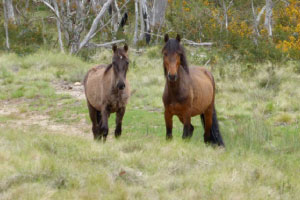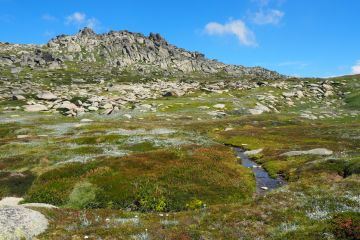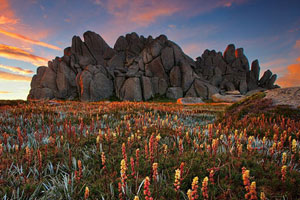
As feral horse numbers grow in the Australian Alps in the absence of an effective control program, so too is concern about the escalating damage.
The NSW national parks service is updating its failed 2008 feral horse management plan. It aims to have a draft ‘Wild Horse Management Plan’ by April 2015 and is conducting a series of interactive web-based ‘conversations’ from July until the end of November [extended until 12 Dec 2014]. Get involved by visiting the Protect the Snowies website. One of the discussions until 27 October is ‘What does humane treatment mean to you?’.
The Victorian Government has delayed the release of its draft horse plan, presumably because of the November state election, but we welcome the Environment Minister’s acceptance that all options are now on the table, including aerial shooting.
A Guardian story: A time to cull? The battle over Australia’s brumbies gives an excellent and stark account of the environmental and welfare impacts of ‘swelling numbers’ of feral horses. The one thing we take issue with is the statement that ‘even now, conservationists are not game to talk publicly about aerial culling’. We and other groups have been publicly calling for it for some years now.
ANU ecologists Don Driscoll and Sam Banks in The grim story of the Snowy Mountains’ cannibal horses (The Conversation) compare the fate of feral horses and the environment under the current approach and with aerial shooting. They find that, ‘over ten years, more horses suffer and die, and the environmental impacts are substantially worse without aerial culling than with it’.
The Invasive Species Council received this thoughtful piece from one of our southern NSW supporters, Graham Scully.
At almost the same time as NPWS began a review of the management of wild (read feral) horses in Kosciuszko National Park, the National Museum of Australia mounted a major exhibition ‘Spirited: Australia’s horse story‘.
Diane Thompson, noticing that the exhibition didn’t refer at all to the problems of feral horses in Australia’s alpine regions, negotiated with the museum to contribute to a blog, in which the spectrum of thoughts and feelings about horses in our natural environments is being shared. Diane’s piece Horses in the high country: Is there a ‘dark side’ to the presence of horses in Australia? has generated many comments.
Another site that is highly interesting to me is Horses for Discourses, a critical examination of the horse in Australian culture. As a psychologist, I have been fascinated by the strength of opposing views on all kinds of issues and the apparent inability of different camps to listen to or be influenced by opposing arguments. It’ss well worth putting in the time to begin to understand the background and long-held attitudes to horses in Australia’s culture.
Scroll through Phar Lap’s heart and war horses to:
- Scenes from Snowy river: early bushmen’s cruelty to horses, the horse as a cultural symbol and its connection to who we are as a nation
- the similar issues over ferals / mustangs in the USA
- the true history of the stockman and why we, as Australians, want so much to believe in the noble stockman
- another dark side, the stockman and his horse in colonisation and dispossession of the Aboriginal people
- the Bulletin debates, 1809-1910 between writers and poets, Lawson and Patterson on the virtues of the city VS the bush and the question of why as we become more urban do we want to cling more to the bushman-hero myth.
- Some must read poetry. Here is just one verse from Francis Kenna’s ‘Banjo, of the Overflow’.
I am tired of reading prattle of the sweetly-lowing cattle
Stringing out across the open with the bushmen riding free;
I am sick at heart of roving up and down the country droving,
And of alternating damper with the salt-junk and the tea.
Read also
80,000 feral horses for the Australian Alps? >>




